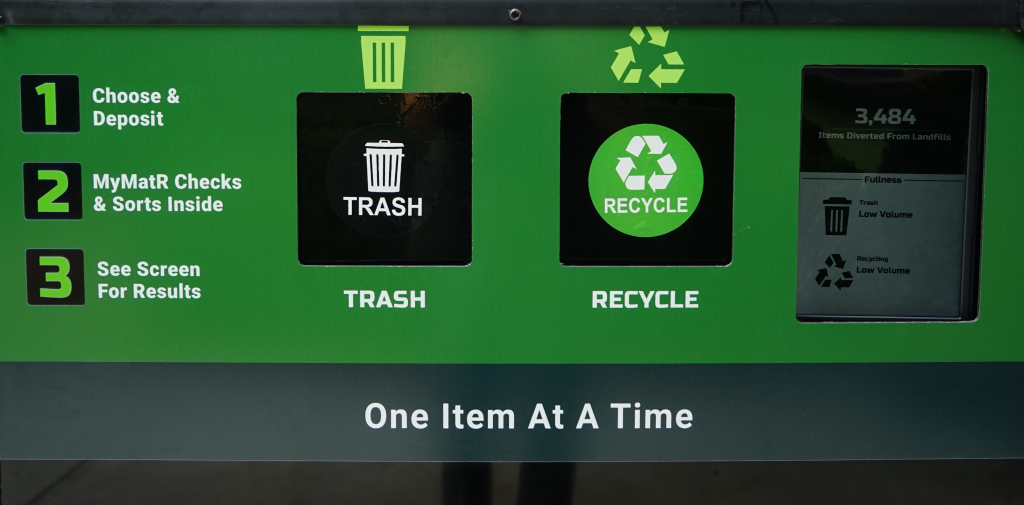Starting a Recycling Program with MyMatR
A large office building campus engaged MyMatR, a leader in waste technology, to evaluate and enhance its recycling procedures. The review found that Recyclable waste was not being recycled. This meant that the campus could reduce waste costs by recovering the value of recyclables and improving the public image as a sustainable facility.
The customer installed several MyMatR Smart Waste Containers to collect data about the waste stream. The MyMatR Smart Waste Container uses AI to automatically sort recyclables from trash while collecting data to inform waste management improvements. The device also collects data on the waste stream to enable process changes.

Engaging the Public
The Smart Waste Container features an interactive display (Figure 1) that prompts users to decide whether an item is recyclable. Correct choices are rewarded with Congratulations! message, while incorrect choices receive feedback and the waste its still goes to the correct waste bin. Since recycling rules vary by community, users may not always be aware of local guidelines. The MyMatR Data Dashboard tracks user sorting behavior, highlighting areas for improvement.

Figure 2 shows that depositors identified trash (green) correctly (left column). The recyclable results in the right column show that trash was incorrectly put in the recyclable opening. The trash (green) is larger than the recyclable material (gray). Contamination is a major problem for public waste containers. If separate trash and recycling waste containers are typical passive bins, the recycling contamination could be so high that the useful recycling material would be rejected and go to a landfill.
Opportunity Cost of Not Recycling
Ignoring recycling waste incurs significant opportunity costs for a business. The tangible costs include lost savings on disposal fees by not reducing landfill-bound waste and forgoing revenue from selling recyclables like metals or paper. The graph in Figure 3 shows that more than half of the waste in the MyMatR waste container in the office building complex was recyclable; this recycling revenue loss from one container could be hundreds of dollars per year. Not recycling also hides the opportunity to reduce costs of resource efficiency, such as recycling cuts costs for raw materials and energy. Other sources of revenue can include: reduced labor preparing corporate and government recycling reports and generating revenue through digital advertising on MyMatR container displays.

Non-financially, a business risks its reputation, as customers favoring sustainability may shift to eco-friendly competitors, eroding loyalty and market share. Regulatory benefits, like tax incentives for green practices, are missed, while future fines loom if laws tighten.
Employee morale and talent attraction may suffer too, as workers value environmental responsibility, increasing turnover costs. Long-term, not recycling exposes a business to rising material and disposal expenses as resources dwindle.
The exact cost varies by industry and scale. Indirect losses, like damaged goodwill, are less tangible but impactful. Skipping recycling sacrifices savings, income, and strategic edges while inviting higher costs and competitive risks over time.
Starting a Recycling Program
The next step to build a recycling program will be to use MyMatR’s data to measure recycling efficiency and begin changing waste processes. Initial decisions will include defining the customer’s recycling goals and the payoff from financial and non-financial sources. The MyMatR data will drive continuous process improvement as the organization learns more about its own waste. Changing waste management operations will take time, but the benefits of user engagement, recycling dollars earned, and reduction of waste pollution will be worth the effort.


